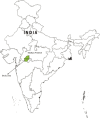Socio-cultural and service delivery dimensions of maternal mortality in rural central India: a qualitative exploration using a human rights lens
- PMID: 25840595
- PMCID: PMC4385127
- DOI: 10.3402/gha.v8.24976
Socio-cultural and service delivery dimensions of maternal mortality in rural central India: a qualitative exploration using a human rights lens
Abstract
Background: Despite the avoidable nature of maternal mortality, unacceptably high numbers of maternal deaths occur in developing countries. Considering its preventability, maternal mortality is being increasingly recognised as a human rights issue. Integration of a human rights perspective in maternal health programmes could contribute positively in eliminating avertable maternal deaths. This study was conducted to explore socio-cultural and service delivery-related dimensions of maternal deaths in rural central India using a human rights lens.
Design: Social autopsies were conducted for 22 maternal deaths during 2011 in Khargone district in central India. The data were analysed using thematic analysis. The factors associated with maternal deaths were classified by using the 'three delays' framework and were examined by using a human rights lens.
Results: All 22 women tried to access medical assistance, but various factors delayed their access to appropriate care. The underestimation of the severity of complications by family members, gender inequity, and perceptions of low-quality delivery services delayed decisions to seek care. Transportation problems and care seeking at multiple facilities delayed reaching appropriate health facilities. Negligence by health staff and unavailability of blood and emergency obstetric care services delayed receiving adequate care after reaching a health facility.
Conclusions: The study highlighted various socio-cultural and service delivery-related factors which are violating women's human rights and resulting in maternal deaths in rural central India. This study highlights that, despite the health system's conscious effort to improve maternal health, normative elements of a human rights approach to maternal health (i.e. availability, accessibility, acceptability, and quality of maternal health services) were not upheld. The data and analysis suggest that the deceased women and their relatives were unable to claim their entitlements and that the duty bearers were not successful in meeting their obligations. Based on the findings of our study, we conclude that to prevent maternal deaths, further concentrated efforts are required for better community education, women's empowerment, and health systems strengthening to provide appropriate and timely services, including emergency obstetric care, with good quality.
Keywords: India; maternal death; maternal health; right to health; rights-based approach.
Figures
Similar articles
-
The influence of social and cultural practices on maternal mortality: a qualitative study from South Punjab, Pakistan.Reprod Health. 2021 May 18;18(1):97. doi: 10.1186/s12978-021-01151-6. Reprod Health. 2021. PMID: 34006307 Free PMC article.
-
A community-based investigation of avoidable factors for maternal mortality in Zimbabwe.Stud Fam Plann. 1996 Nov-Dec;27(6):319-27. Stud Fam Plann. 1996. PMID: 8986030
-
Praying until death: revisiting three delays model to contextualize the socio-cultural factors associated with maternal deaths in a region with high prevalence of eclampsia in India.BMC Pregnancy Childbirth. 2019 Aug 28;19(1):314. doi: 10.1186/s12884-019-2458-5. BMC Pregnancy Childbirth. 2019. PMID: 31455258 Free PMC article.
-
The untold story: how the health care systems in developing countries contribute to maternal mortality.Int J Health Serv. 1992;22(3):513-28. doi: 10.2190/91YH-A52T-AFBB-1LEA. Int J Health Serv. 1992. PMID: 1644513 Review.
-
Too far to walk: maternal mortality in context.Soc Sci Med. 1994 Apr;38(8):1091-110. doi: 10.1016/0277-9536(94)90226-7. Soc Sci Med. 1994. PMID: 8042057 Review.
Cited by
-
How do accountability problems lead to maternal health inequities? A review of qualitative literature from Indian public sector.Public Health Rev. 2018 Mar 16;39:9. doi: 10.1186/s40985-018-0081-z. eCollection 2018. Public Health Rev. 2018. PMID: 29568671 Free PMC article. Review.
-
Is it home delivery or health facility? Community perceptions on place of childbirth in rural Northwest Tanzania using a qualitative approach.BMC Pregnancy Childbirth. 2020 May 6;20(1):270. doi: 10.1186/s12884-020-02967-z. BMC Pregnancy Childbirth. 2020. PMID: 32375691 Free PMC article.
-
Perceptions, health seeking behavior and utilization of maternal and newborn health services among an indigenous tribal community in Northeast India-a community-based mixed methods study.Front Public Health. 2023 Jul 6;11:1139334. doi: 10.3389/fpubh.2023.1139334. eCollection 2023. Front Public Health. 2023. PMID: 37483938 Free PMC article.
-
Narratives on why pregnant women delay seeking maternal health care during delivery and obstetric complications in rural Ghana.BMC Pregnancy Childbirth. 2019 Jul 23;19(1):260. doi: 10.1186/s12884-019-2414-4. BMC Pregnancy Childbirth. 2019. PMID: 31337348 Free PMC article.
-
Gender Transformative Interventions for Perinatal Mental Health in Low and Middle Income Countries-A Scoping Review.Int J Environ Res Public Health. 2022 Sep 28;19(19):12357. doi: 10.3390/ijerph191912357. Int J Environ Res Public Health. 2022. PMID: 36231655 Free PMC article.
References
-
- World Health Organisation, UNICEF, UNFPA, The World Bank. Geneva: World Health Organisation; 2005. Health and Millennium Development Goals.
-
- Hogan MC, Foreman KJ, Naghavi M, Ahn SY, Wang M, Makela SM, et al. Maternal mortality for 181 countries, 1980–2008: a systematic analysis of progress towards Millennium Development Goal 5. Lancet. 2010;375:1609–23. - PubMed
-
- World Health Organisation, UNICEF, UNFPA, The World Bank. Geneva: World Health Organisation; 2012. Trends in maternal mortality: 1990 to 2010. WHO, UNICEF, UNFPA and The World Bank estimates.
-
- Hussein J, Braunholtz D, D'Ambruoso L. Maternal health in the year 2076. Lancet. 2008;371:203–4. - PubMed
-
- Starrs AM. Safe motherhood initiative: 20 years and counting. Lancet. 2006;368:1130–2. - PubMed
MeSH terms
LinkOut - more resources
Full Text Sources
Other Literature Sources
Medical


